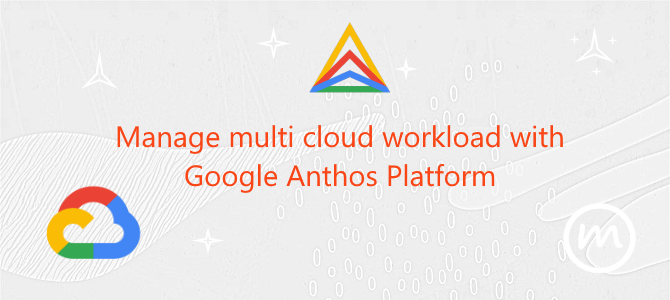Manage multi-cloud workloads with Google Anthos Platform

As an enterprise you may have networking, storage, and compute on multiple clouds and in your own data centre. In such a scenario,
- How can you consistently secure and operate existing apps?
- How can you develop and deploy the new apps across those disparate locations?
- How can you get centralized visibility and management of those resources?
Well, the answer is Anthos.
What is Anthos?
Anthos is a modern application management platform that provides a consistent development and operations experience for cloud and on-premises environments.
Anthos is a hybrid and multi-cloud platform that aims has emerged as a management console for cross platform workloads. With Anthos, it easier for enterprises to manage their applications regardless of where they choose to run them – on different public cloud services or on-premise. For GCP, Anthos is a differentiator that can bring it more enterprise workloads as it competes with AWS and Azure.
Currently Anthos is being well positioned as an umbrella brand for multiple services aligned with the themes of application modernization, cloud migration, hybrid cloud, and multi-cloud management.
How can Anthos help?
Let's say you use containers on the clouds and develop apps using services on Google Cloud and AWS. Regardless of platform, you will need policy enforcement across your IT footprint. To manage these across platforms, you need monitoring and logging systems, and you need to integrate that data into meaningful categories, like business data, operational data, and alerts. You might use operational data and alerts to inform optimizations, automations, and to set policies or SLOs. You might use business data to do all those things and to deploy third-party apps. Then to enact the changes you've decided on, you need to act on different specific parts of the system. That means digging into each tool for policy enforcement, securing services, orchestrating containers, and managing infrastructure management. All of this work is in addition to what it takes to develop and deploy your own apps. To repeat this set of tasks and data across a hybrid and multi-cloud landscape becomes very complex rapidly. When it is a hybrid and multi-cloud landscape, things get worse.
Anthos helps solve these challenges. With Anthos, you get a consistent way to manage with similar infrastructure management, container management, service management, and policy enforcement across your platform. As a result, you gain observability across your platforms in one single place, including business information, alerts, and operational information. With this information, you might decide to optimize, automate, and set policies or SLOs, or might use the out-of-box machine learning models to make automated suggestions. You decide to make decisions based on the recommendations and apply them to different management layers.
Anthos now supports Environs. What are Environs?
Environs are the way to create logical sets of underlying Kubernetes clusters, regardless of which platform these clusters live on. By considering grouping and managing sets of clusters as logical environs, you can think about and work with your applications at the right level of detail for what you need to do, be it business insights over the entire system, setting for a dev environment, or troubleshooting data for a specific cluster. Using environs, each part of the functional stack can take declarative direction about configuration, compliance, and more.
A Platform for Administrators
Anthos provides platform administrators a single place to monitor and manage their landscape, including policy control and marketplace access. This reduces person hours in management, enforcement, discovery, and communication. Anthos also provides them an out-of-the-box structured view of their entire system, including services, clusters, and more, simplifying their view and management so they can improve security, use resources more efficiently, and demonstrate measurable success.
A Platform to modernize App Development
Anthos is also a platform to modernize application development. It uses environs to enforce policies and processes and abstracts away that cluster and container management from the application development teams. Anthos allows you to easily abstract away infrastructure from application teams by making it easy for them to incorporate a wide variety of CICD solutions on top of environs, allowing you to view and manage your applications at the right level of detail.
Thus, Anthos simplifies and provides a consistent view across your company's landscape so you can improve security, use resources more efficiently, innovate faster, and demonstrate measurable success.
Multi Cloud Deployment
A year back in Apr 2019, Google officially announced the launch of its Anthos multi-cloud application modernization platform at its Cloud Next conference. The promise of Anthos was always that it would allow enterprises to write their applications once, package them into containers and then manage their multi-cloud deployments across GCP, AWS, Azure and their on-prem data centres.
Recently, Google has announced the general availability of AWS support. Microsoft Azure support remains in preview and will be available later this year.
What’s the future?
Google has just begun to capitalize on changing the narrative around the cloud-native ecosystem. Anthos is rapidly emerging as the preferred platform for running enterprise workloads. All in all, the benefits of Google’s push for Anthos will extend beyond the industry itself.
Refer here to my previous article about Anthos
Refer Anthos Documentation
Check out here to read more about Hybrid and Multi-Cloud Architecture Patterns